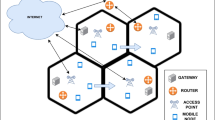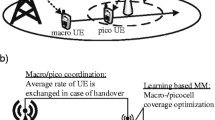Abstract
Mobile wireless networks encounter a critical challenge in maintaining uninterrupted connectivity during node movement and network disruptions. Analytical engines are tailored to assess both node-level parameters like movement and communication patterns, as well as network-level aspects such as bandwidth and signal strength indicators. These analyses inform a decision engine that facilitates node handovers between networks, guided by specific parameters and constraints based on prevailing network conditions. This approach optimizes network connectivity, improving essential Quality of Service (QoS) measures like reduced delay, increased throughput, minimized energy consumption, and enhanced packet delivery ratio. Ensuring smooth network transitions requires advance notification to the target network, allowing preparations for incoming nodes and enhancing the likelihood of uninterrupted communication. However, crafting an effective pre-intimation engine often involves complexity, potentially impacting QoS metrics. To address this, our paper introduces a metaheuristic handover model utilizing network augmentation and game theory, deploying incremental learning to streamline handovers' complexities. Across various heterogeneous network scenarios, this model showcases a 10% boost in energy efficiency, 15% higher throughput, an 8% delay reduction, and a 3% improvement in packet delivery ratio compared to standard models. Ongoing evaluations aim to deepen insights into the model's performance across diverse network scenarios. Future research will focus on integrating additional network parameters and optimizing the learning algorithm for further efficiency gains."







Similar content being viewed by others
Data Availability
It can be available by sending mail to g3p3k3@gmail.com.
References
Wu, Y., Zhao, G., Ni, D., & Du, J. (2021). Dynamic handoff policy for RAN slicing by exploiting deep reinforcement learning. EURASIP Journal on Wireless Communications and Networking, 2021(1), 1–17.
Tan, X., Chen, G., & Sun, H. (2020). Vertical handover algorithm based on multi-attribute and neural network in heterogeneous integrated network. EURASIP Journal on Wireless Communications and Networking. https://doi.org/10.1186/s13638-020-01822-1
Valiveti, H. B., & Kumar, B. A. (2021). Handoff strategies between wireless fidelity to light fidelity systems for improving video streaming in high-speed vehicular networks. International Journal of Communication Systems, 34(6), e4285.
Devi, M. K., & Kandaswamy, U. (2020). Modified Artificial Bee Colony with firefly algorithm based spectrum handoff in cognitive radio network. International Journal of Intelligent Networks., 1, 67–75. https://doi.org/10.1016/j.ijin.2020.07.002
Ali, E. S., Hasan, M. K., Hassan, R., Saeed, R. A., Hassan, M. B., Islam, S., et al. (2021). Machine learning technologies for secure vehicular communication in internet of vehicles: recent advances and applications. Security and Communication Networks, 2021, 1–23.
Yajnanarayana, V., Rydén, H., & Hévizi, L. (2020). 5G handover using reinforcement learning. In 2020 IEEE 3rd 5G World Forum (5GWF) (pp. 349–354). IEEE.
Li, D., Li, D., & Xu, Y. (2019). Machine learning based handover performance improvement for LTE-R. In 2019 IEEE International Conference on Consumer Electronics-Taiwan (ICCE-TW) (pp. 1–2). IEEE.
Wang, L., Han, D., Zhang, M., Wang, D., & Zhang, Z. (2021). Deep reinforcement learning-based adaptive handover mechanism for VLC in a hybrid 6G network architecture. IEEE Access, 9, 87241–87250.
Gurumallu, P. K., & Shankaraiah. (2022). NLADSS: Design of connectivity as a service (CaaS) model using node-level augmentation & dynamic sleep scheduling for heterogeneous wireless network handoffs. International Journal of Intelligent Engineering and Systems, 15(5), 273–283. https://doi.org/10.22266/ijies2022.1031.25
Shi, Q., Shao, W., Fang, B., Zhang, Y., & Zhang, Y. (2019). Reinforcement learning based spectrum handoff scheme with measured PDR in cognitive radio networks. Electronics Letters. https://doi.org/10.1049/el.2019.2259
Han, Z., Lei, T., Lu, Z., Wen, X., Zheng, W., & Guo, L. (2019). Artificial intelligence-based handoff management for dense WLANs: A deep reinforcement learning approach. IEEE Access, 7, 31688–31701.
Soujanya, J., & Shankaraiah, S. (2022). A traceability system for processed products based on blockchain technology. In 2022 IEEE 2nd Mysore Sub Section International Conference (MysuruCon) (pp. 1–6). IEEE.
Bazán, J. V. C., Rasgado, C., Salas, S. L., Lamont, F. G., & Bueno, J. C. (2019). Artificial intelligence techniques in handover decision: A brief re-view. Revista Ingeniantes, 6(1), 1.
Oyewobi, S. S., Hancke, G. P., Abu-Mahfouz, A. M., & Onumanyi, A. J. (2019). An effective spectrum handoff based on reinforcement learning for target channel selection in the industrial Internet of Things. Sensors, 19(6), 1395.
Boutaba, R., Salahuddin, M., Limam, N., Ayoubi, S., Shahriar, N., Estrada-Solano, F., & Caicedo Rendon, O. (2018). A comprehensive survey on machine learning for networking: Evolution, applications and research opportunities. Journal of Internet Services and Applications. https://doi.org/10.1186/s13174-018-0087-2
Alkhateeb, A., Beltagy, I., & Alex, S. (2018). Machine learning for reliable mmwave systems: Blockage prediction and proactive handoff. In 2018 IEEE Global conference on signal and information processing (GlobalSIP) (pp. 1055–1059). IEEE.
Memon, S., & Maheswaran, M. (2019). Using machine learning for handover optimization in vehicular fog computing. In Proceedings of the 34th ACM/SIGAPP Symposium on Applied Computing (pp. 182–190).
Sun, Y., Feng, G., Qin, S., Liang, Y. C., & Yum, T. S. P. (2017). Reinforcement learning based handoff for millimeter wave heterogeneous cellular networks. In GLOBECOM 2017–2017 IEEE Global Communications Conference (pp. 1–6). IEEE.
Zhang, C., Patras, P., & Haddadi, H. (2019). Deep learning in mobile and wireless networking: A survey. IEEE Communications Surveys & Tutorials, 21(3), 2224–2287.
Ozturk, M., Gogate, M., Onireti, O., Adeel, A., Hussain, A., & Imran, M. (2019). A novel deep learning driven low-cost mobility prediction approach for 5G cellular networks: The case of the Control/Data Separation Architecture (CDSA). Neurocomputing. https://doi.org/10.1016/j.neucom.2019.01.031
Pries, R., Staehle, D., Tran-Gia, P., & Gutbrod, T. (2008). A Seamless Vertical Handover Approach. In L. Cerdà-Alabern (Ed.), Wireless Systems and Mobility in Next Generation Internet EuroNGI 2008 Lecture Notes in Computer Science. (Vol. 5122). Berlin: Springer. https://doi.org/10.1007/978-3-540-89183-3_14
Sun, Y., Feng, G., Qin, S., Liang, Y. C., & Yum, T. S. P. (2017). The SMART handoff policy for millimeter wave heterogeneous cellular networks. IEEE Transactions on Mobile Computing, 17(6), 1456–1468.
Sun, J., Qian, Z., Wang, X., & Wang, X. (2020). Es-dqn-based vertical handoff algorithm for heterogeneous wireless networks. IEEE Wireless Communications Letters, 9(8), 1327–1330.
Chen, J., Wang, Y., Li, Y., & Wang, E. (2018). QoE-aware intelligent vertical handoff scheme over heterogeneous wireless access networks. IEEE Access, 6, 38285–38293.
Koushik, A. M., Matyjas, J. D., Hu, F., & Kumar, S. (2017). Channel/beam handoff control in multi-beam antenna based cognitive radio networks. IEEE Transactions on Cognitive Communications and Networking, 4(1), 30–42.
Koushik, A. M., Hu, F., & Kumar, S. (2017). Intelligent spectrum management based on transfer actor-critic learning for rateless transmissions in cognitive radio networks. IEEE Transactions on Mobile Computing, 17(5), 1204–1215.
Lin, S., Che, N., Yu, F., & Jiang, S. (2019). Fairness and load balancing in SDWN using handoff-delay-based association control and load monitoring. IEEE Access, 7, 136934–136950.
Sun, X., & Ansari, N. (2017). Adaptive avatar handoff in the cloudlet network. IEEE Transactions on Cloud Computing, 7(3), 664–676.
Mansouri, M., & Leghris, C. (2020). A use of fuzzy TOPSIS to improve the network selection in wireless multiaccess environments. Journal of Computer Networks and Communications, 2020, 1–12.
Kassar, M., Kervella, B., & Pujolle, G. (2008). An intelligent handover management system for future generation wireless networks. EURASIP Journal on Wireless CommunicationsNetworking. https://doi.org/10.1155/2008/791691
Niu, X. (2020). A secure and reliable transmission scheme for low loss high performance wireless communication system based on IoT. Journal of Ambient Intelligence and Humanized Computing, 1–8.
Hebb, D. O. (2005). The organization of behavior: A neuropsychological theory. Psychology Press.
Toosi, A., Bottino, A. G., Saboury, B., Siegel, E., & Rahmim, A. (2021). A brief history of AI: How to prevent another winter (a critical review). PET Clinics, 16(4), 449–469.
McCarthy, J., Minsky, M. L., Rochester, N., & Shannon, C. E. (2006). A proposal for the dartmouth summer research project on artificial intelligence, august 31, 1955. AI magazine, 27(4), 12–12.
Mazumdar, E., Ratliff, L. J., & Sastry, S. S. (2020). On gradient-based learning in continuous games. SIAM Journal on Mathematics of Data Science, 2(1), 103–131.
Zheng, Q., Zhao, P., Li, Y., Wang, H., & Yang, Y. (2021). Spectrum interference-based two-level data augmentation method in deep learning for automatic modulation classification. Neural Computing and Applications, 33(13), 7723–7745.
Zheng, Q., Zhao, P., Zhang, D., & Wang, H. (2021). MR-DCAE: Manifold regularization-based deep convolutional autoencoder for unauthorized broadcasting identification. International Journal of Intelligent Systems, 36(12), 7204–7238.
Zheng, Q., Zhao, P., Wang, H., Elhanashi, A., & Saponara, S. (2022). Fine-grained modulation classification using multi-scale radio transformer with dual-channel representation. IEEE Communications Letters, 26(6), 1298–1302.
Zheng, Q., Tian, X., Yu, Z., Wang, H., Elhanashi, A., & Saponara, S. (2023). DL-PR: Generalized automatic modulation classification method based on deep learning with priori regularization. Engineering Applications of Artificial Intelligence, 122, 106082.
Zheng, Q., Tian, X., Yu, Z., Jiang, N., Elhanashi, A., Saponara, S., & Yu, R. (2023). Application of wavelet-packet transform driven deep learning method in PM2.5 concentration prediction: A case study of Qingdao China. Sustainable Cities and Society, 92, 104486.
Navarro-Ortiz, J., Romero-Diaz, P., Sendra, S., Ameigeiras, P., Ramos-Munoz, J. J., & Lopez-Soler, J. M. (2020). A survey on 5G usage scenarios and traffic models. IEEE Communications Surveys & Tutorials, 22(2), 905–929.
Funding
This research received no specific funding.
Author information
Authors and Affiliations
Contributions
Prasanna Kumar G contributed to this paper as part of his Ph.D. research, while receiving guidance and supervision from Dr. Shankaraiah.
Corresponding author
Ethics declarations
Conflict of interest
The authors declare no competing interests.
Additional information
Publisher's Note
Springer Nature remains neutral with regard to jurisdictional claims in published maps and institutional affiliations.
Rights and permissions
Springer Nature or its licensor (e.g. a society or other partner) holds exclusive rights to this article under a publishing agreement with the author(s) or other rightsholder(s); author self-archiving of the accepted manuscript version of this article is solely governed by the terms of such publishing agreement and applicable law.
About this article
Cite this article
Prasanna Kumar, G., Shankaraiah, N. A Metaheuristic Handover Model Using Network Augmentation and Game Theory for Seamless Connectivity in Heterogeneous Networks. Wireless Pers Commun 134, 133–150 (2024). https://doi.org/10.1007/s11277-024-10896-9
Accepted:
Published:
Issue Date:
DOI: https://doi.org/10.1007/s11277-024-10896-9




